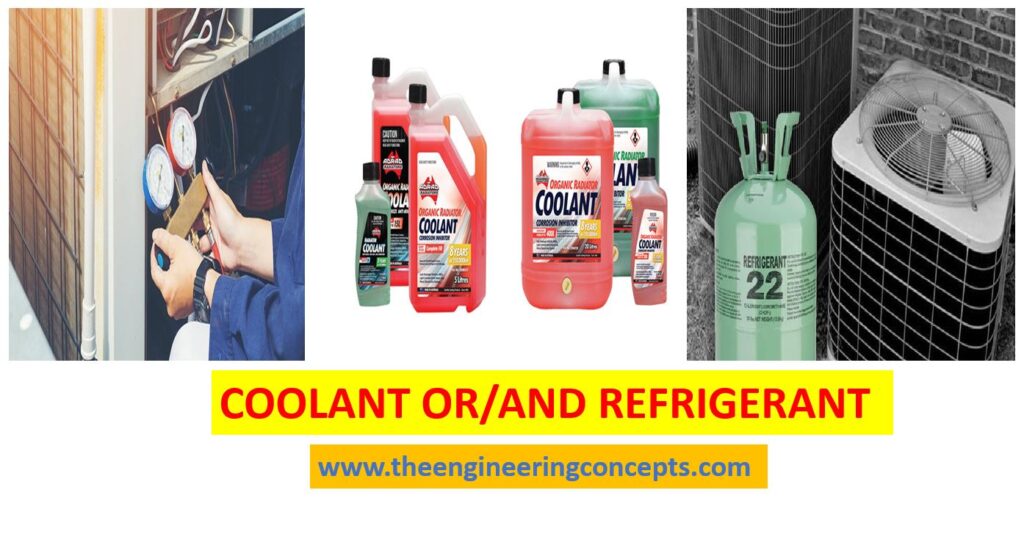During our day-to-day life and engineering carriers, we all usually come across some equipment, or machinery, that involves coolants or/and refrigerants, typically in cars and refrigerators, respectively, but still, many of us are unaware of what exactly these two fluids are and what role each of them plays in practicality. So, this article is just the way-out to fill and rectify all such gaps and misconceptions, if any.
Even though, English dictionary gives the same meaning for both, coolant and refrigerant, but we, engineers, should not just end up accepting it and relax. So, let’s just get down once, take a look and understand what they really are and what they actually do and how they are playing a vital role in one’s life.
COOLANT
A liquid, a mixture of two components- water and an antifreeze (ex.- Ethylene glycol, propylene glycol, etc.) (typically 50/50)- just like oil, serves the basic function of collecting the unwanted heat and dissipating it to environment, but with an additional feature of antifreeze protection to an engine.
Also Read : Heat Exchanger Design
Also Read : What is Pump Head and Shut-off Head ?
Ideally, coolant has high thermal capacity, low viscosity, low cost, non-toxic nature, chemically inert and neither causes nor promotes corrosion of the cooling system. Some applications also require the coolant to be an electrical insulator.
Where, why, how:
When we turn ON a vehicle, basically we are turning ON its engine that makes the vehicle able to run. Now when it has been turned ON, it starts generating heat (unused energy or losses: since no practical engine is ideal or a Carnot engine) and over the running time, this heat load increases. But this generated heat is unrequired by engine
and has to be regulated or removed for proper and long-lasting working of engine. So here is where the engine’s cooling system is utilized, which is carrying a ‘coolant’ in itself and keeping the engine from overheating. So, what happens inside the engine compartment is that when we start our engine, a water pump circulates the coolant through the engine and radiator, from where it collects any unnecessary heat and comes back to dissipate it to surroundings (go by the picture above for visualization). After the engine has reached a certain temperature, by losing any unwanted heat to coolant, a thermostat opens to control the flow of coolant throughout the circuit; leading to a healthy engine life.
PRO: Thermostat stops the flow of heat-loaded coolant on a cold engine to assist quicker warm ups.
PREMIUM: Here is where and how the coolant is charged and indicated under the hood.
REFRIGERANT
Without refrigerant, there would be no air conditioning, refrigeration or freezing technology.
Got any idea? OK!
Refrigerant is basically a fluid, liquid or gas, with very low boiling point. Where water boils at 100oC, these refrigerants boil at even <0oC, for example refrigerant R134a (boiling point: -26.3oC), These liquids readily absorb heat from the surroundings and can provide refrigeration or air conditioning when combined with other components such as compressors and evaporators.
How it works-
Air conditioners and refrigerators carry refrigerant inside their copper coils. You might have seen at your home some service engineer recharging refrigerant into the compressor of the refrigerator or air conditioning system. This low temperature gas, after compression is a relatively high temperature liquid. As and when this liquid gains any heat energy from surroundings, it vaporizes and these high energy vapours move towards condenser where a condenser fan cools down these vapours, leading to the dissipation of heat to the environment and converting the vapours back to a low temperature liquid. This low temperature liquid, then while passing through an evaporator blower is heated by hot air, and again getting converted into low temperature gas. To this gas, compressor again performs compression and the cycle repeats.
UPDATE: R32 is the new refrigerant getting the most interest. R134a has 8.5% higher coefficient of performance than R32. R32 gives 10% less power consumption than refrigerant-22.
Okay, at last, it’s not only ‘Vs’, it is also a ‘similar’ thing-
- Both are rust inhibitors, i.e., when added them, you don’t need to add any additional rust inhibitor or preventor.
- Both can leak, so preventive maintenance suggested
- So, basically both are keeping the system cool!
ImageSource : Ace Car Conditioning; CarCare Hunt; arranco; Natrad; abc 33/40
Article Source : A/C Pro; Team Valvoline; Wikipedia

